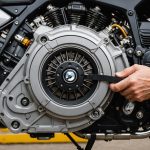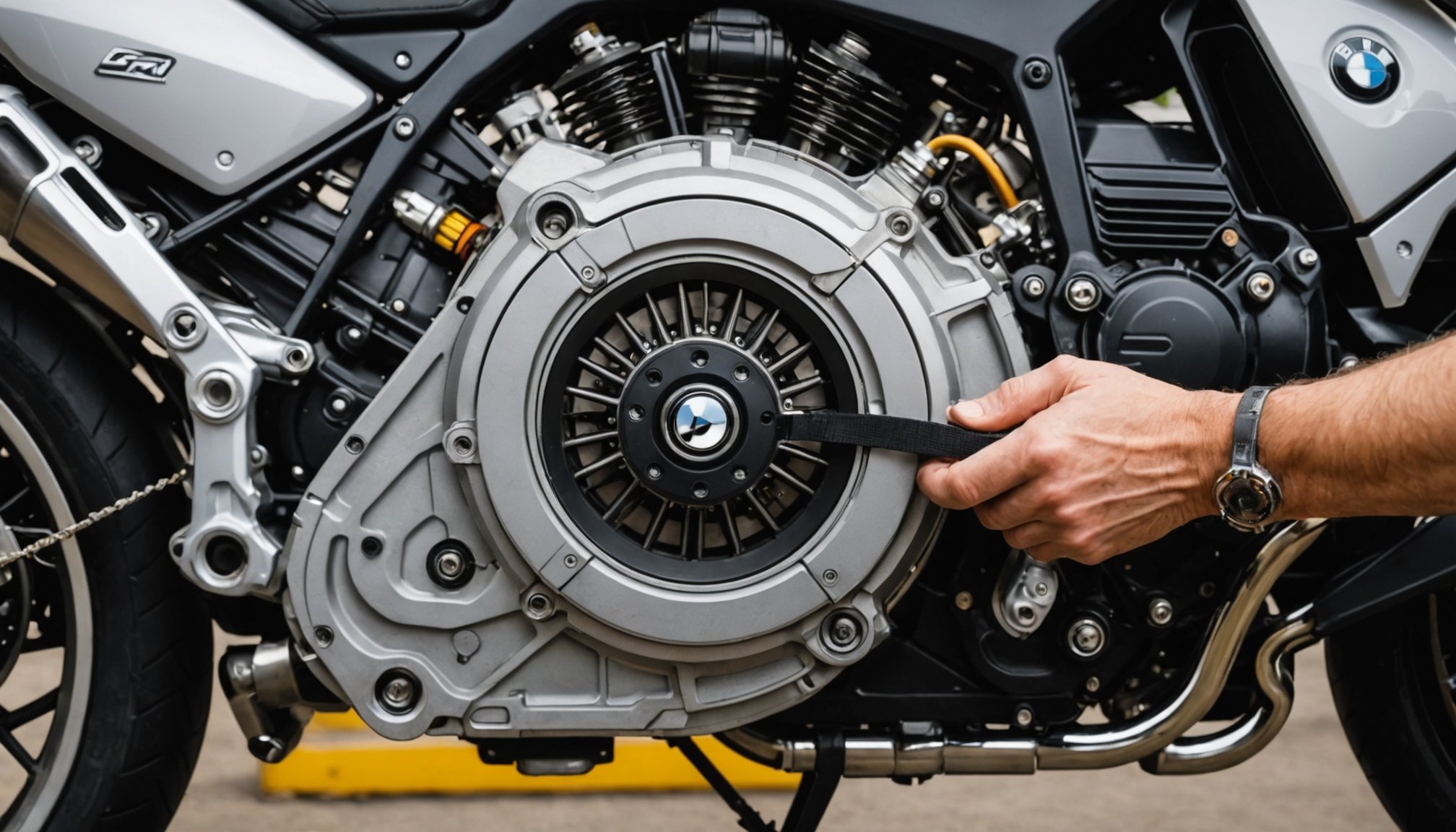A Step-by-Step Guide to Replacing the Alternator Belt on Your BMW R1200RT
Replacing the alternator belt on your BMW R1200RT is a crucial maintenance task that ensures your motorcycle’s electrical system functions smoothly. Here’s a comprehensive guide to help you through the process.
Preparing for the Job
Before you start, it’s essential to prepare yourself and your workspace. Here are some steps to follow:
Also to read : Ultimate Guide to Enhancing the Braking Performance of Your Suzuki GSX-R600
Gather Necessary Tools and Parts
- Alternator Belt: Ensure you have the correct replacement belt for your BMW R1200RT. You can find this part at specialized BMW motorcycle spares suppliers like Motobins[2].
- Tools: You will need a set of basic tools including a socket set, wrenches, and possibly a torque wrench.
- Workshop Manual: Having the BMW Motorrad workshop manual for your specific model can be incredibly helpful. It provides detailed instructions and diagrams specific to your bike[3].
Ensure Your Safety
- Always wear protective gear such as gloves and safety glasses.
- Make sure your motorcycle is on a level surface and securely supported by a center stand or paddock stand.
General Instructions and Precautions
Consult Your Rider Manual
Before starting any maintenance work, it’s a good idea to consult your rider manual. The manual will provide general instructions and specific precautions for your BMW R1200RT.
Check the ASC and Other Systems
Ensure that the Automatic Stability Control (ASC) and other systems like the Anti-Theft System and Hazard Warning Lights are not active. Switch off the ignition and let the bike sit for a few minutes to discharge any residual power.
Have you seen this : Achieve flawless wheel alignment: expert tips for perfectly aligning the front and rear wheels of your bmw s1000xr
Tyre Pressure and Rear Wheel
Make sure your tyre pressure is optimal, as specified in your rider manual. Incorrect tyre pressure can affect the balance and stability of your bike during the replacement process.
Step-by-Step Replacement Process
Step 1: Locate the Alternator Belt
The alternator belt is located at the front of the engine, near the alternator. It drives the alternator and other accessories.
Step 2: Remove the Fairings and Panels
To access the alternator belt, you will need to remove some of the fairings and panels. This includes the front fairing and possibly the tank cover. Use the appropriate tools and follow the sequence outlined in your workshop manual to avoid damaging any components.
Step 3: Release the Tensioner
The alternator belt is held in place by a tensioner. Release the tensioner by loosening the bolt that holds it in place. This will allow you to remove the old belt.
Step 4: Remove the Old Belt
Carefully pull the old belt off the pulleys. If it is stuck, you may need to use a bit of force, but be careful not to damage the pulleys or other components.
Step 5: Install the New Belt
Place the new belt around the pulleys, ensuring it is properly seated. Make sure the belt is not twisted or misaligned.
Step 6: Adjust the Tensioner
Re-tighten the tensioner bolt to the specified torque setting. You can find this information in your workshop manual. Over-tightening can damage the belt and other components.
Post-Replacement Checks
Reassemble the Fairings and Panels
Once the new belt is installed, reassemble the fairings and panels in the reverse order of how you removed them.
Check the Electrical System
Start the engine and check the electrical system to ensure everything is working correctly. Look for any warning lights on the dashboard, such as the ASC warning light or the battery status indicators.
Test the Alternator
Take your bike for a short test ride to ensure the alternator is charging the battery properly. You can check the voltage at the battery terminals using a multimeter.
Common Issues and Troubleshooting
Possible Causes of Failure
- Incorrect Tension: If the belt is not tensioned correctly, it can lead to premature wear or failure.
- Misalignment: Ensure the belt is properly aligned on the pulleys to avoid uneven wear.
- Overheating: If the engine is overheating, it can cause the belt to degrade faster.
Self Diagnosis
If you notice any issues after replacing the belt, such as the warning light for the ASC or the battery status indicators, refer to your rider manual for self-diagnosis procedures.
Practical Tips and Advice
Regular Maintenance
Regularly check the condition and tension of the alternator belt to prevent unexpected failures. This is especially important if you plan long trips.
Use the Right Tools
Using the right tools can make the job much easier and reduce the risk of damaging your bike. For example, using a torque wrench ensures that the tensioner bolt is tightened to the correct specification.
Seek Professional Help
If you are not comfortable with this replacement, it is highly recommended to take your bike to a BMW Motorrad workshop. They have the expertise and specialized tools to do the job efficiently and correctly.
Additional Accessories and Upgrades
High Output Alternator Kits
If you plan to add more electrical accessories to your bike, such as additional lights or a GPS system, consider upgrading to a high output alternator kit. This ensures your electrical system can handle the increased load[2].
Rust Protection
To protect your bike from rust, especially in areas prone to moisture, consider using rust protection products available from suppliers like Motobins[2].
Replacing the alternator belt on your BMW R1200RT is a manageable task if you follow the right steps and precautions. Here is a summary of the key points:
- Prepare thoroughly: Gather the necessary tools and parts, and ensure your safety.
- Follow general instructions: Consult your rider manual and check other systems like ASC and tyre pressure.
- Perform the replacement carefully: Remove fairings, release the tensioner, remove the old belt, install the new belt, and adjust the tensioner.
- Check post-replacement: Reassemble the fairings, check the electrical system, and test the alternator.
- Troubleshoot common issues: Identify possible causes of failure and perform self-diagnosis if necessary.
- Maintain regularly: Check the belt condition and tension regularly to prevent unexpected failures.
By following this guide, you can ensure your BMW R1200RT remains in top condition, ready for your next adventure.
Detailed Checklist for Replacement
-
Tools Needed:
-
Socket set
-
Wrenches
-
Torque wrench
-
Paddock stand or center stand
-
Safety glasses and gloves
-
Parts Needed:
-
New alternator belt
-
Workshop manual
-
Steps to Follow:
-
Remove fairings and panels
-
Release the tensioner
-
Remove the old belt
-
Install the new belt
-
Adjust the tensioner
-
Reassemble the fairings and panels
-
Check the electrical system
-
Test the alternator
Comparative Table: Old vs. New Alternator Belt
| Feature | Old Alternator Belt | New Alternator Belt |
|---|---|---|
| Condition | Worn, possibly cracked | New, no signs of wear |
| Tension | Possibly loose or over-tightened | Correctly tensioned according to specifications |
| Performance | May cause electrical system issues | Ensures smooth electrical system operation |
| Safety | Could lead to unexpected failure | Reduces risk of unexpected failure |
| Maintenance | Requires frequent checks | Less frequent checks needed initially |
Quotes and Insights
- “Regularly checking the condition and tension of the alternator belt can prevent unexpected failures and ensure a smooth ride,” says a BMW Motorrad technician.
- “Using the right tools and following the correct procedures is crucial to avoid damaging your bike during maintenance tasks,” advises a seasoned rider.
- “If you are not comfortable with this replacement, it is highly recommended to take your bike to a BMW Motorrad workshop. They have the expertise and specialized tools to do the job efficiently and correctly,” recommends a motorcycle mechanic.
By following this detailed guide, you can ensure that replacing the alternator belt on your BMW R1200RT is a successful and stress-free experience. Happy riding











